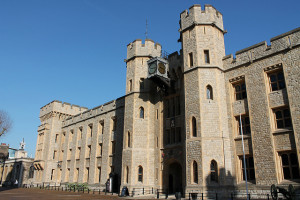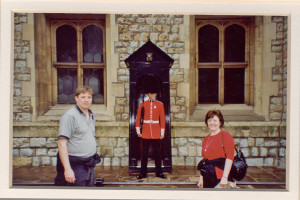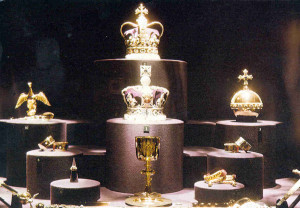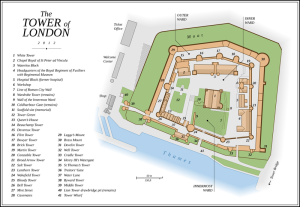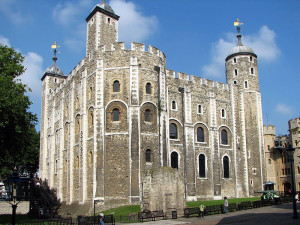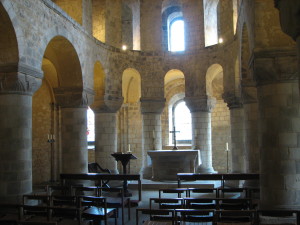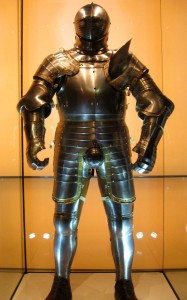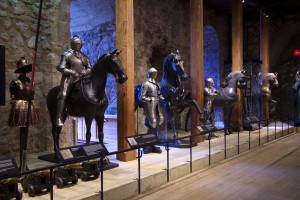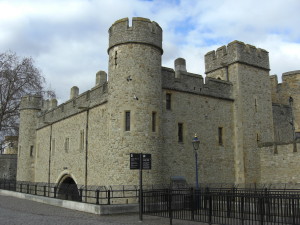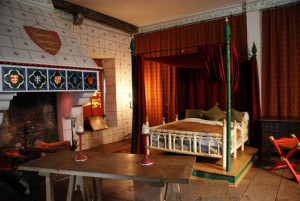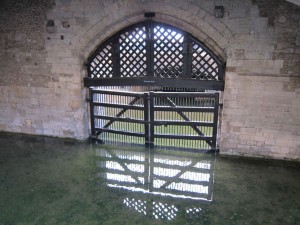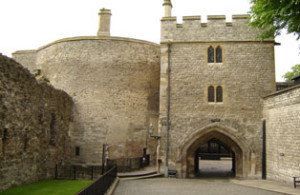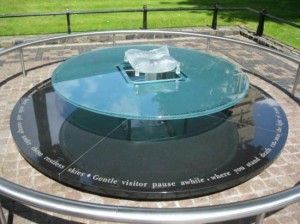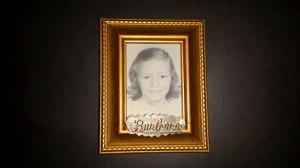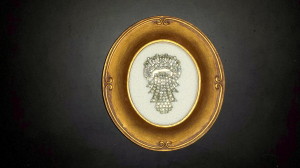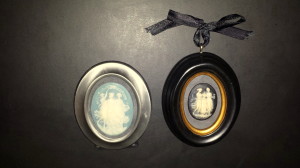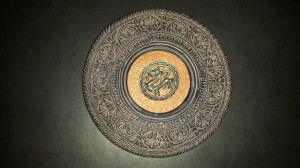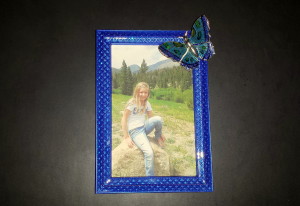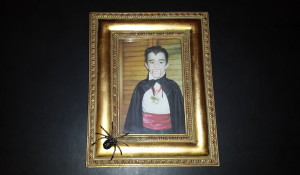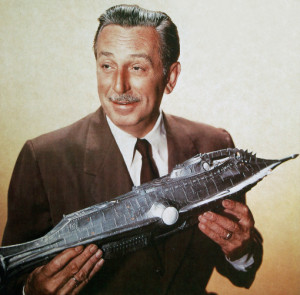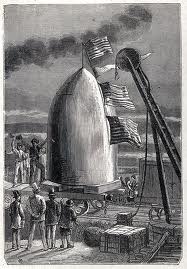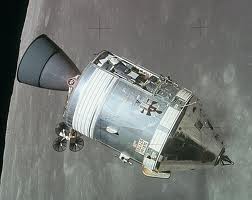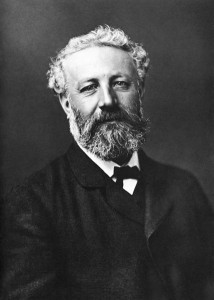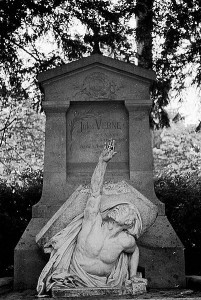There are so many interesting things to see and learn during a visit to the Tower of London and it can be very overwhelming and that is the reason I have written two separate posts. In the previous Travel post, Tower of London (Part One), I went into details about the history as a royal palace, fortress and prison. In this second post, I will discuss the history of the Jewel House which holds the famous Crown Jewels of England. I will also discuss two very different iconic residents of the Tower of London; the ravens whose presence has a legendary beginning connected to the historic Tower grounds and the Yeoman of the Guards who perform many duties such as tour guides and security force for the Tower of London.
The Jewel House and the Crown Jewels of England
Over the past centuries the Tower of London has stored the crowns, robes, jewels and other valuable items which were worn by the kings and queens of England. The tradition of the monarch’s coronation ceremony has been performed for over 1,000 years but the coronation regalia, known collectively as the Crown Jewels, are relatively modern pieces. Several buildings throughout the Tower of London have held these items for safekeeping and in 1665 the Crown Jewels were first put on display for the public to view.
The current Jewel House was built in 1967 as the west wing of the Waterloo Barracks. The Crown Jewels were displayed in a secured area in the basement of the building with the other royal items, such as the goldplate serving pieces, were displayed on an upper floor. Over time the high visitor attendance to the Jewel House in Tower of London required a larger area. Construction on the new Jewel House began in 1992 and was completed two years later in 1994. The new Jewel House was three times larger than the old one and could accommodate the large crowds more efficiently. New advanced security and display technology were also incorporated into the design, such as 2 inch thick shatter proof glass, filtered air and fiber-optic lighting were used in the construction of the display cases.
TRAVEL TIP: Before entering the Jewel House, be sure to take a photo in front with the Tower Guard sentry post, it makes a great souvenir of a day at the Tower of London!
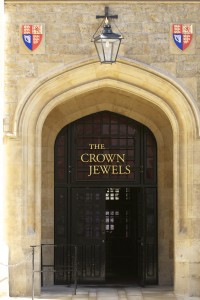 Upon entering the Jewel House, the first area visitors will encounter is called the Hall of Monarchs. On display in this room are the crests and seals, also known as the coat of arms, of the British monarchs from William the Conqueror to the most recent, Queen Elizabeth II. It is a wonderful chance to compare both the similar and sometimes different elements used by the various monarchs during the past centuries.
Upon entering the Jewel House, the first area visitors will encounter is called the Hall of Monarchs. On display in this room are the crests and seals, also known as the coat of arms, of the British monarchs from William the Conqueror to the most recent, Queen Elizabeth II. It is a wonderful chance to compare both the similar and sometimes different elements used by the various monarchs during the past centuries.
As visitors proceed through the building, three short films are shown in adjoining areas. One of those films is of the 1953 coronation ceremony of Queen Elizabeth II; it was the first time the solemn coronation ceremony was shown on television. Take a moment to stop and see the very young Queen being crowned but more importantly take note of the coronation regalia that visitors will see later on their tour of the Jewel House. (For more detailed information about the 1953 coronation ceremony, please click on the following post called the Coronation of Queen Elizabeth II)
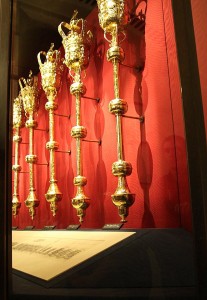 The next area in the Jewel House is a long hallway called the Processional Way; this is where the royal maces are displayed. The mace was originally a medieval weapon made of wood and metal but over time it became a symbol of the king or queen’s rank and authority. The more ornate ceremonial maces were made of precious metal and studded with jewels to reflect the sovereign’s high rank and is usually held by someone who precedes the king or queen in a procession.
The next area in the Jewel House is a long hallway called the Processional Way; this is where the royal maces are displayed. The mace was originally a medieval weapon made of wood and metal but over time it became a symbol of the king or queen’s rank and authority. The more ornate ceremonial maces were made of precious metal and studded with jewels to reflect the sovereign’s high rank and is usually held by someone who precedes the king or queen in a procession.
Next, is the room displaying the Crown Jewels of England and two slow moving walkways are located on either side running the length of the display cases of the various crowns of the Kings and Queens of England. Don’t worry if you missed anything in the display cases or want a different view of the crowns, just take the moving walkway on the other side for another look! Be sure to look for the Imperial State Crown worn by the Queen annually at the State Opening of Parliament, the small Queen Victoria Diamond Crown, and the Queen Mother Crown with the large 105.6 carat Koh-i-Nor diamond. (For more detailed information about the crowns in the collection, please click on the following post called the Crown Jewels of England – Part Two)
In the next room, the Coronation Regalia is on display including the coronation robe worn by the current queen, Queen Elizabeth II. After the execution of King Charles I in 1649, Oliver Cromwell had the original crown jewels either sold or melted down to be made into coins. Later after the Restoration, with the loss or destruction of the crown jewels, some would say that King Charles II was “a king with no crown” and a new set of coronation regalia was made for him in 1661. More than half of the items on display in this room date back to that time in history, please sure to look for the Coronation Spoon which is the oldest item in the collection and is believed to be the only item that survived the destruction of the crown jewels by Oliver Cromwell. Another item to look for is the Sceptre with Cross with the very large 530.2 carat Cullinan I diamond which was added to the sceptre in 1910, it is the largest cut diamond in the world.
The last room on the Jewel House tour holds the royal plate collection which is a collection of serving pieces used by the king or queen for special occasions. Look for the largest item in the collection, the beautifully decorated silver gilt Grand Punch Bowl made in 1830, it is weighs 546 pounds and it was originally intended to be a wine vessel that would hold 144 bottles of wine. One of the most unique items in the collection is the Salt of State which was made after the Restoration in 1660, the function of the piece is to hold a variety of spices for a banquet but in looks like a golden fairytale castle.
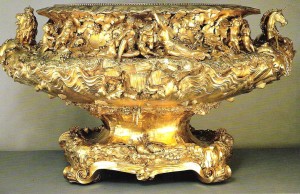
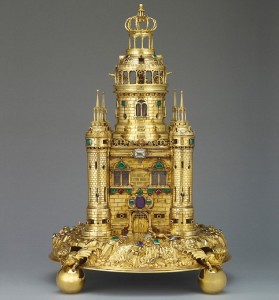
The legend of the Tower of London Ravens
Over the centuries, wild ravens were very common throughout Britain and the area of the Tower of London was within their range. The ravens were thought to frequent the Tower supposedly attracted by the smell of the corpses of the executed enemies of the Crown the ravens would feed on the remains. Unfortunately, with the growth of the city London and the surrounding countryside, over time the numbers of ravens dramatically decreased.
The legend of the Tower of London ravens can be traced to the reign of King Charles II. It seems that the flight of the ravens was beginning to interfere with work of the royal astronomer, John Flamsteed, who conducted his daily observations with a telescope located in the observatory of the White Tower. King Charles, who greatly disliked the ravens’ droppings on the Tower grounds, originally ordered that the ravens would be killed but he was advised that it was unlucky to kill a raven and if this order was carried out “the Tower would fall and he would lose his kingdom”. Ever the pragmatist, King Charles sent out a new order to solve the problem and the Royal Observatory was moved to Greenwich and the ravens’ wings would be clipped to keep them at the Tower. Over the centuries, the captive ravens became associated with the tradition and superstition that as long as there were ravens held at the Tower of London “the Crown will not fail and Britain will remain strong”.
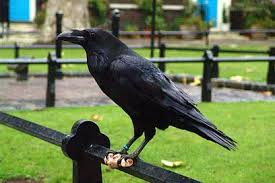 Currently the group of ravens held captive at the Tower consistently numbers a total of seven Common Ravens. At some time over the centuries, six was determined the lucky number of ravens, so there are six ravens that roam the Tower grounds and an additional raven is held as an extra. The ravens can only fly a very short distance because the flight feathers on one of their wings are clipped to prevent them from leaving the Tower grounds. To identify the individual birds, each raven is marked with a different colored band on their leg and they are also given a name by their Yeoman Warders caretakers.
Currently the group of ravens held captive at the Tower consistently numbers a total of seven Common Ravens. At some time over the centuries, six was determined the lucky number of ravens, so there are six ravens that roam the Tower grounds and an additional raven is held as an extra. The ravens can only fly a very short distance because the flight feathers on one of their wings are clipped to prevent them from leaving the Tower grounds. To identify the individual birds, each raven is marked with a different colored band on their leg and they are also given a name by their Yeoman Warders caretakers.
The diet of the Tower ravens includes fresh fruit, cheese and fresh meat such as beef, chicken or lamb. They are also given vitamins and other supplements, such as chopped boiled eggs and cod liver oil. The ravens are well-cared for as visitors will note by the healthy weight and shining coats of the pampered Tower ravens. The visitors are also advised not to feed the birds and are warned that the ravens will bite if they feel threatened. The ravens held in captivity at the Tower of London have recorded lifespans of over 40 years.
The Yeoman Warders of the Tower of London
The Yeoman Warders are the ceremonial guardians of the Tower of London. Once responsible for guarding the prisoners of the Tower and the British Crown Jewels, today the Yeoman Warders act as tour guides who have extensive knowledge of the history of the Tower. Sometimes the Yeoman Warders are incorrectly referred to as the Yeoman of the Guard, which is the separate distinct group of royal bodyguards of the British monarch. The Yeoman Warders were first formed in 1485 by King Henry VII and then later in 1509, his son King Henry VIII moved the official royal residence of the monarch from the Tower of London and the group split into two separate groups. The majority of the Yeoman of the Guard went with the King but a much smaller group of twelve Yeoman were retained at the Tower so it could maintain the formal status of royal place. The main function of the remaining Yeomen became the warder of the Tower prisoners and the name was changed to Yeoman Warders to reflect their actual duties.
Currently there are 27 Yeoman Warders and one Chief Warder at the Tower of London. The requirement to become a Yeoman Warder is they must be a retired member of the Armed Forces of England or the Commonwealth, a former senior non-commissioned officer or petty officer with at least 22 years of service and also hold the Long Service and Good Conduct medal. In 2007, this normally male dominated institution changed and the first female Yeoman Warder, Moira Cameron, was sworn in. More changes where to come for Yeoman Warder requirements and until very recently only non-commissioned officers from the Army, Royal Marines and Royal Air Force were eligible to apply for the position. The Royal Navy had been exempt because they took an oath to the Admiralty and not the Queen. In 2011, this allegiance oath reverted back to the Queen and the first Naval Yeoman Warder had applied, was accepted and sworn in. The Yeoman Warders and their families are required to live within the Tower of London and some of the housing dates back to the 13th century. The Tower has its own community with a Resident Governor, chaplain, doctor and even a pub. The only problem is that when the Tower is locked at night to keep out intruders, the Yeoman Warders and their families are locked in and are prevented from leaving the Tower until morning.
The Yeoman Warders normally wears a dark blue uniform with red trimmings. For official state occasions, such as the Queen visit to the Tower, they wear a red and gold uniform which is very similar to the Yeoman of the Guard. This uniform is referred to as the Tudor State Dress which has changed very little from when it was in the 1400s and it is very uncomfortable to wear because of the high white collar and heavy fabric.
The Yeoman Warders are sometimes called “Beefeaters” which has a historical origin as the Yeoman from centuries past were given the right to eat as much beef as they wanted at the King’s table and basically the Yeoman were a very well feed group! But according the modern-day Yeoman Warder in charge as the Ravenmaster, it is the Tower Raven that are the real “beef-eaters” because of their daily diet of meat!
The Ceremony of the Keys
A long standing tradition is the Ceremony of the Keys which is held every night at the Tower of London and it has been performed in the same way since the 14th century. The Chief Yeoman Warder, who is dressed in Tudor watchcoat, meets his military escort of Tower of London Guards at exactly 9:53 p.m. Together they will march to lock the main gates of the Tower. After securing the Tower Gate, the Chief Yeoman Warder with his military escort will march down Water Lane. On the way back into the Tower, the group is stopped by a sentry that shouts, “Halt! Who goes there?” The Yeoman Chief Warder replies, “The keys” “Who’s Keys”, the sentry says. “Queen Elizabeth’s keys” the Chief Warder answers back. The sentry states, “All is well” and allows the group to pass.
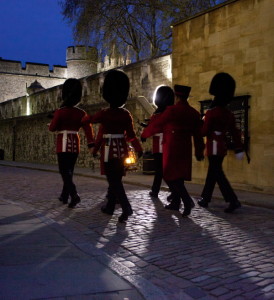
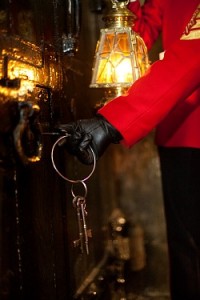
The Yeoman Chief Warder and his military escort proceed through the Bloody Tower Archway and into the main area of the Tower. The group halts at the bottom of a set of stairs known as the Broadwalk Steps. At the top of the stairs another group of Tower Guards are called to present arms (a military command shown as a sign of respect). The Chief Warder raises his hat and calls out, “God save Queen Elizabeth”. The ceremony is concluded when the Chief Warder takes the keys to the residential section of the Tower to a building known as the Queen’s House and the keys are stored for safekeeping while the Last Post is sounded for the night which officially ends the day at the Tower of London.
TRAVEL NOTE: When visiting the Tower of London, I would definitely recommend the free one hour tour given by a Yeoman Warder guide. These tours are an excellent way to learn the history of the Tower, but they are also surprising entertaining and humorous despite the serious topics of imprisonment, execution and torture.
For more information, such as hours of operation and admission cost for the Tower of London, please see their website at www.hrp.org.uk/TowerOfLondon

